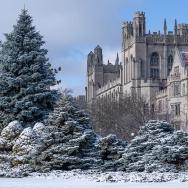Editor’s note: This story was first published in 2012 and was adapted from an article written by Wendell Hutson for the examiner.com.
John W. Rogers Sr. spent his childhood in Knoxville, Tenn., dreaming of flight.
“I remember walking from the town to the airport and walking up and touching an airplane, just to be able to say I touched an airplane,” he said in 2012.
Rogers, who died in 2014 at age 95, later became a licensed pilot, enlisted in the Army Air Corps and served in the legendary 99th Pursuit Squadron of the Tuskegee Airmen — the first African American pilots in the U.S. military.
Rogers returned to Chicago after World War II, graduating from the University of Chicago Law School in 1948 before beginning a long career as a Cook County Juvenile Court judge.
Several Airmen attended the University, and the program produced numerous veterans who went on to great success in life. The rolls of UChicago-Tuskegee alumni include such notable figures as Benjamin Davis, X’33, who commanded the Airmen throughout World War II and later became the first African American general in the Air Force; original Airman James Wiley, MBA’54; educators Stewart Fulbright, MBA’47, and Quentin Smith, AM’46; as well as applied mathematician Paul Byrd, SB’38, SM’41.
Before 1940, African Americans were barred from flying for the U.S. military. Civil rights organizations pressured the federal government, resulting in the formation of an African American pursuit squadron based in Tuskegee, Ala., in 1941. Although collectively called Tuskegee Airmen, the 99th Pursuit Squadron included engine mechanics, sheet metal workers, armorers, weather observers, parachute riggers, support staff, and all the personnel who kept the planes in the air.
Rogers Sr. was already a licensed pilot when he enlisted in the military.
“I figured if I was going to be in combat, I have a better chance of surviving in the air, rather than on the ground,” Rogers said. “And I was lucky, because I did not get killed and served my country proudly.”
Rogers and his fellow pilots quickly proved that they had the skills and tenacity to do the job.
“We were a tight group. We stuck together and watched each other’s backs, and that is why we were so successful proving folks wrong,” he said.
Rogers excelled as a combat pilot, rising to the rank of captain and flying more than 100 missions in the war’s European theater.
In a letter to his sister, composed at age 23 as he was about to ship out for Europe, he wrote: “We black Americans will be asked to die fighting for something we don’t enjoy at home,” but it “would not be so bad to die if I could contribute my bit to develop respect from the white man for the negro.”
In 2012, Mark Hanson, curator of the Chanute Air Museum in Rantoul, Ill., located on the former Chanute AFB, where the 99th was first activated, said Rogers was regarded as a pilot who “could put a 500-pound bomb through a building’s window.”
After the war, Rogers returned to Chicago to attend the Law School. Although he was not admitted on his first attempt, according to his son, John W. Rogers Jr., LAB’76, he returned to the school in his captain’s uniform and essentially argued his way in.
At the Law School, Rogers Sr. met Jewel Stradford, who became the first African American woman to graduate from the Law School, whom he later married. Overcoming the era’s racial barriers to become a prominent, highly respected lawyer, Rogers Sr. was ultimately appointed a Juvenile Court judge.
In 2007, Rogers Sr. was among 300 Tuskegee Airmen to receive the Congressional Gold Medal, Congress’s highest civilian honor.
Rogers Sr. never stopped dreaming of flying.
“I hope there are planes in heaven I can fly, because you know how much I love to fly.”

